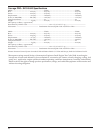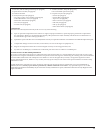
12
Low Idle
Mixture Screw
Idle Speed
(RPM)
Adjustment
Screw
Fuel Solenoid
If, aer checking the items listed above, the engine is
hard to start, runs roughly, or stalls at low idle speed, it
may be necessary to adjust or service the carburetor.
Adjust Carburetor
NOTE: Some engines may have a fixed (capped)
idle fuel adjusting screw or limiter cap. On
these engines, do not aempt steps 1 and 2
below. Proceed directly to Step 3. On limiter
equipped models, adjustment can only be
performed within the limits allowed by the
cap.
1. Idle Fuel Adjustment: with the engine stopped,
turn the low idle fuel adjusting screw in
(clockwise) until it booms lightly. See Figures 16
and 17.
NOTE: The tip of the low idle fuel adjusting screw is
tapered to critical dimensions. Damage to the
needle tip and the seat in carburetor body will
result if the needle is forced.
2. Preliminary Seings: Turn the adjusting screw
out (counterclockwise) from lightly boomed
2-1/4 turns.
3. Start the engine and run at half throle for 5 to 10
minutes to warm up. The engine must be warm
before making final seings (step 4).
4. Low Idle Speed (RPM) Seing: Place the throle
control into the idle or slow position. Set the low
idle speed to 1200 RPM* (± 75 RPM) by turning the
low idle speed adjusting screw in or out. Check
the speed using a tachometer.
*NOTE: The actual low idle speed depends on
the application – refer to equipment
manufacturer’s recommendations. The
recommended low idle speed for basic engines
is 1200 RPM. To ensure best results when
seing the low idle fuel needle, the low idle
speed must not exceed 1200 RPM
(± 75 RPM).
5. If proper operation is not restored aer adjusting,
carburetor servicing by an authorized Kohler
Engine Service Dealer may be required.
Models with Governed Idle System
An optional governed idle control system is supplied
on some engines. The purpose of this system is to
maintain a desired idle speed regardless of ambient
conditions (temperature, parasitic load, etc.) that may
change. Engines with this feature contain a small
secondary spring connected between the governor
lever and the lower adjustment tab of the main bracket.
See Figure 18.
Figure 17. Carburetor Adjustment Access
Locations (Latch Removed For Clarity).
Troubleshooting
If engine troubles are experienced that appear to be
fuel system related, check the following areas before
adjusting the carburetor.
• Make sure the fuel tank is filled with clean, fresh
gasoline.
• Make sure the fuel tank cap vent is not blocked
and that it is operating properly.
• If the fuel tank is equipped with a shut-off valve,
make sure it is open.
• If the engine is equipped with an in-line fuel filter,
make sure it is clean and unobstructed. Replace
the filter if necessary.
• Make sure fuel is reaching the carburetor. This
includes checking the fuel lines and fuel pump
for restrictions or faulty components, replace as
necessary.
• Make sure the air cleaner element is clean and
all air cleaner element components are fastened
securely.
Low Idle Mixture Screw
Idle Speed (RPM)
Adjustment Screw
Element
Figure 16. Carburetor Details.


















